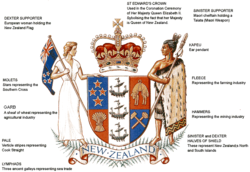- Coat of arms of New Zealand
-
The Arms of Her Majesty in Right of New Zealand 
Versions 
Version as used on the flag of the Governor-General
The old-style coat of arms (1911–1956)Details Armiger Elizabeth II, Queen of New Zealand Adopted 1911 (1956) Crest St Edward's Crown Escutcheon Three ships, Southern Cross, Fleece, Wheat sheaf and crossed hammers Supporters European woman and a Maori Chieftain Compartment Two leaves of silver fern Motto English: NEW ZEALAND The coat of arms of New Zealand is the official symbol of New Zealand. The initial coat of arms was granted by King George V on the 26 August 1911, and the current version was granted by Queen Elizabeth II in 1956.
Contents
History and design
Until 1911, New Zealand used the same national coat of arms as the United Kingdom. When New Zealand became a Dominion in 1907, it was decided that a new Coat of Arms was required, and a design competition was held. The winning entry was a design by James McDonald, a draughtsman in the Department of Tourist and Health Resorts. Since being granted its own arms in 1911, New Zealand's arms have remained similar to the current design, with minor changes in 1956.
Since 1911, the central shield has remained unaltered: a quartered shield containing in the first quarter four stars representing the Southern Cross constellation, as depicted on the national flag, but with the stars in different proportions; in the second quarter, a golden fleece representing the farming industry; in the third, a wheat sheaf representing agriculture; and in the fourth, two hammers representing mining and industry. Over all this is a pale, a broad vertical strip, with three ships representing the importance of sea trade, and the immigrant nature of all New Zealanders.
Before 1956, the shield was identical, but the surrounding features were different. The crest was a demi-lion (the upper half of a rampant lion) holding the British Union Flag, and the scroll at the shield's base featured the then motto of the country, "Onward". Early renditions of the Coat of Arms are often featured with more stylised scrolling rather than fern leaves.
The original supporters were also slightly different. The woman had reddish-brown hair, and both figures faced forward rather than towards the shield. Though there is no direct documentary evidence, it is likely that the original model for the woman was Wellington socialite Alice Spragg. The model for the Māori warrior is unknown.
1956 redesign
One month prior to New Zealand's adoption of the Statute of Westminster on 25 September 1947, a special committee was formed by then Prime Minister Peter Fraser. The committee was responsible for the "redrawing and standardisation of the Coat of Arms." Consisting of Alistair McIntosh, Joseph Heenan, Dr Colin Aickman, Frank Corner, Foss Shanahan and Professor John Cawte Beaglehole.[1] One of the committee's concerns was that the female supporter looked too much like a "Soviet heroine". Following the election of the first National Government in 1949, the new Attorney-General, John Marshall (later Deputy Prime Minister and Prime Minister) took up responsibility for the committee. Marshall requested the woman to be re-drawn based on the likeness of Grace Kelly, a favourite actress of his.[1]
The shield is now supported by two figures, a blonde woman of European descent holding the New Zealand flag, and a Māori warrior holding a taiaha (Māori ceremonial spear). The shield is topped with the St Edward's Crown, and beneath the shield are two silver fern leaves and a scroll bearing the words "New Zealand".
The woman is said by some to be a depiction of Zealandia, a common national personification of New Zealand during the first half of the 20th century.
The coat of arms are the basis of the Queen's Royal Standard of New Zealand.
References
- ^ a b Harshan Kumarasingham (2010). Onward with Executive Power - Lessons from New Zealand 1947 - 1957. Institute of Policy Studies, Victoria University of Wellington. ISBN 9781877347375. http://ips.ac.nz/publications/publications/show/288.
External links
- New Zealand coat of arms with extended history and images
- MCH page on the Coat of Arms
- Blazon at Encyclopaedia of New Zealand 1966
- Zealandia, Britannia's daughter: the woman symbolising New Zealand (particularly in the early twentieth century) by Denis Glover.
Seals and coats of arms of Oceania Sovereign states Dependencies and
other territories- American Samoa
- Christmas Island
- Cocos (Keeling) Islands
- Cook Islands
- Easter Island
- French Polynesia
- Guam
- Hawaii
- New Caledonia
- Niue
- Norfolk Island
- Northern Mariana Islands
- Pitcairn Islands
- Tokelau
- Wallis and Futuna
Categories:- National coats of arms
- National symbols of New Zealand
Wikimedia Foundation. 2010.


